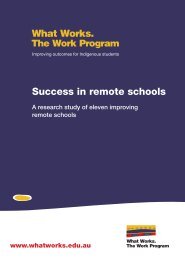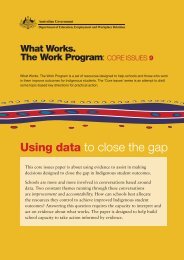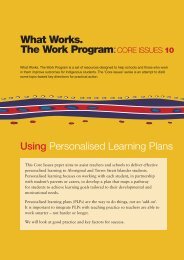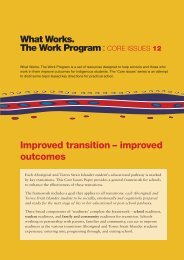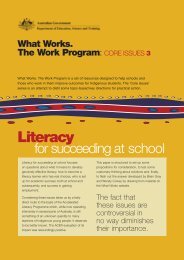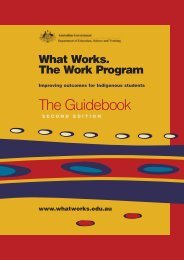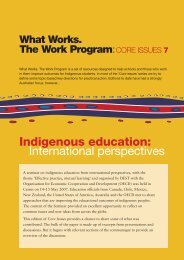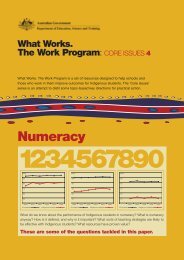Bound for Success Scope and Sequence Statements
Bound for Success Scope and Sequence Statements
Bound for Success Scope and Sequence Statements
- No tags were found...
You also want an ePaper? Increase the reach of your titles
YUMPU automatically turns print PDFs into web optimized ePapers that Google loves.
MATHEMATICSNumberConcept In Year 1the student:In Year 2the student:In Year 3the student:In Year 4the student:In Year 5the student:In Year 6the student:In Year 7the student:In Year 8the student:In Year 9the student:Operations,calculating <strong>and</strong>problem-solvingin Number• Underst<strong>and</strong>s addition as aconcept of ‘finding thetotal’ <strong>and</strong> the ‘+’ symbolas representing theoperation• Underst<strong>and</strong>s addition <strong>and</strong>subtraction concepts,symbols <strong>and</strong> words thatindicate these including‘difference’, ‘total’, ‘sum’,‘altogether’, ‘adding to’,‘taking away’• Works out <strong>and</strong> extendsaddition <strong>and</strong> subtractionfacts <strong>and</strong> recognises bywords <strong>and</strong> situations wheneach is required (e.g.knows that “how much is 4<strong>and</strong> 3?” means add 4 <strong>and</strong> 3together)• Recalls or calculatesmentally addition <strong>and</strong>multiplication facts <strong>for</strong> anypair of whole numbers upto 5 (i.e. 5 + 5 <strong>and</strong> 5 x 5)• Recalls or calculatesmentally addition <strong>and</strong>multiplication facts <strong>for</strong> anypair of whole numbers upto 10 <strong>and</strong> uses their inverseoperations when needed(i.e. knows to use the factthat 3 x 5 = 15 to find15 ÷ 3)• Recalls most basicmultiplication facts to 10x 10 <strong>and</strong> mentally extendsto multiply one-digitnumbers by multiples of10 (e.g. says “4 x 90 is 4times 9 lots of ten so it’s36 lots of ten, 360”)• Mentally multiplies doubledigitby single-digitnumbers using partitioningstrategies (e.g. says “6thirty-eights is 6 thirties <strong>and</strong>6 eights which is 180 <strong>and</strong>48, that’s 228”)• Applies number facts <strong>and</strong>properties to carry outmental calculations (e.g.says “the GST on $156 is$15.60 which gives a totalof $171.60”)Underst<strong>and</strong>ing theoperations of addition,subtraction,multiplication <strong>and</strong>division;Choosing the correctoperation <strong>for</strong> aparticular situation<strong>and</strong> using it to solveproblems• Partitions single-digitnumbers using addition<strong>and</strong> subtraction (e.g.partitions 5 as 4 <strong>and</strong> 1, 3<strong>and</strong> 2, 7 take away 2)• Places up to 10 objects inequal groups (e.g. 2 lots of5 pencils, 3 lots of 3 toys)• Partitions 2-digit numbersusing addition <strong>and</strong>subtraction (e.g. partitions16 as 15 + 1, 14 + 2, 13 +3, …) <strong>and</strong> shows this withmaterials• Uses mental strategies tocompute addition <strong>and</strong>subtraction of 1 <strong>and</strong> 2-digitnumbers• Knows all doubles facts to20 (e.g. knows that double19 is 38)• Use words, drawing <strong>and</strong>representations of arrays toexpress ‘lots of’ (e.g. 2 lotsof 3: # # ## # # )• Knows single-digitaddition <strong>and</strong> relatedsubtraction facts bypartitioning (e.g. knows 9+ 7 = 9 + 1 + 6 so it mustbe 10 + 6 which is 16) <strong>and</strong>demonstrates this usingsymbols <strong>and</strong> materials• Uses mental strategies tocompute addition <strong>and</strong>subtraction of 1 <strong>and</strong> 2-digitnumbers <strong>and</strong> choosesbetween mental <strong>and</strong>written methods to do thesame• Uses words <strong>and</strong> models ofarrays to express ‘lots of’<strong>and</strong> solve multiplicationsituations (e.g. uses anarray to determine howmany apples each personwill have if they have 4each)• Knows that subtraction isthe inverse (i.e. ‘undoes’)of addition <strong>and</strong> vice-versa<strong>and</strong> that division is theinverse of multiplication<strong>and</strong> can show theserelationships <strong>for</strong> numbersusing drawings• Knows that subtraction isnot commutative (i.e. 7 – 3≠ 3 – 7)• Uses mental strategies toestimate computationsinvolving a singleoperation (e.g. 45.3 + 190is about 50 plus 200, or250)• Multiplies whole numbersup to 3 digits by numbersup to 10 using mentalstrategies as a first choice<strong>and</strong> other written orcalculator strategies <strong>for</strong>numbers beyond theirmental scope• Recalls addition <strong>and</strong>subtraction facts, <strong>and</strong>works out multiplication<strong>and</strong> related division,applying numberproperties <strong>and</strong> mentalcomputation strategies tolarger numbers (e.g. says“3 eights is 24 so 6 eightswill be double that so 6times 8 is 48”)• Multiplies <strong>and</strong> dividesnumbers by 10 <strong>and</strong> 100mentally <strong>and</strong> shows‘what’s changing’ whenthey do this using a placevalue chart or calculator)• Multiplies whole numbersup to 6 digits by numbersup to 10, using mentalstrategies as a first choice<strong>and</strong> other written orcalculator strategies <strong>for</strong>numbers beyond theirmental scope (e.g. says“4 530 times 3 is 12thous<strong>and</strong> plus onethous<strong>and</strong> 500 – which is13 500 <strong>and</strong> then addanother 90 – answer is 13590”)• Partitions double-digitnumbers in order tomentally multiply bysmall single-digitnumbers (e.g. realises that3 twenty-sixes is the sameas 3 twenties added to 3sixes which is 60 + 18which is 78; factorises 38in order to make thecomputation of 38 x 5easier; thus 38 x 5 = 19 x2 x 5 = 19 x 10 = 190)• Multiplies by tenths <strong>and</strong>hundredths <strong>and</strong> explainsthat multiplying by tenthsis the same as finding onetenth of it <strong>and</strong> multiplyingby one hundredth is thesame as finding onehundredth of it• Multiplies whole numbersup to 6 digits by numbersup to 10 using rounding<strong>and</strong> mental strategies inorder to estimate first,when written <strong>and</strong>calculator methods areneeded (e.g. uses acalculator to multiply62 350 by 5, estimatingthat the answer obtainedwill be between 300 000<strong>and</strong> 400 000 in order tojudge whether the answerobtained on their screen isreasonable)• Partitions double-digitnumbers in order tomentally divide by smallsingle-digit numbers (e.g.realises that 97 ÷ 3 is 90divided by 3 <strong>and</strong> 7 dividedby 3 which is 30 <strong>and</strong> twowith one left over; thirtytwo <strong>and</strong> one left over)• Divides by tenths <strong>and</strong>hundredths <strong>and</strong> explainsthat dividing a number byone tenth makes it ten timeslarger (since there are tentenths in every wholenumber) <strong>and</strong> similarly <strong>for</strong>hundredths• Applies effective writtenmethods (not necessarilyalgorithms) to carry outcomputations with decimalsto at least thous<strong>and</strong>ths (e.g.2.852 x 12.3) by mentallyestimating the result first inorder to judge thereasonableness of theanswer obtained• Knows to divide when thedivisor is less than one(e.g. knows that tocalculate how many piecesof string 0.3 metres longcan be cut from a roll ofstring 2 m long they needto divide 2 m by 0.3 m);Knows to multiply whenthe multiplier is a fractionor decimal less than 1 (e.g.when given the cost of onemetre of ribbon knows tomultiply it by 0.75 to findwhat 0.75 m will cost)• Multiplies <strong>and</strong> dividesdecimals by one-digitnumbers, interpretingremainders <strong>for</strong> division<strong>and</strong> deciding whether toround up or downdepending on the context(e.g. divides 39.5 by 6 toshare $39.50 among 6people, calculates theanswer as 6.58333… <strong>and</strong>knows to round the answerdown to $6.55 because ifthey round up to $6.60there will not be enoughmoney to share equally)• Underst<strong>and</strong>s the effect ofmultiplying <strong>and</strong> dividingby fractional <strong>and</strong> decimalnumbers less than 1 (e.g.when given a number suchas 220 <strong>and</strong> challenged tofind a number to multiplyit by to get 200 using acalculator, selects anumber slightly less than1); Underst<strong>and</strong>s thatdividing a fraction by afraction will result in anumber greater than theinitial fraction (e.g.recognises that 2/5 ÷3/4could not possibly be 1/5)Calculates problemsinvolving two integers <strong>and</strong>a single operation usingeffective written methods(e.g. when calculating 20billion divided by 350 000,or 546 x -389) byestimating first (e.g. says“546 x 389 is about 550times 400 which is about22 000 so I’m expectingabout -22 000”) ; thewritten method will notnecessarily be an algorithmbut may be based on theirunderst<strong>and</strong>ing of numbers<strong>and</strong> number properties(e.g. 546 x 300 + 546 x 80+ 546 x 9)• Shares materials equally(e.g. given 10 objects <strong>for</strong> 5people gives each person2)• Shares <strong>and</strong> groupsmaterials up to 100 (e.g.given 40 objects <strong>and</strong> 6people gives them out <strong>and</strong>notices there are some leftover)• Shares <strong>and</strong> groupsmaterials (<strong>for</strong> single digitdivisors i.e. up to 10shares) up to 1 000)• Underst<strong>and</strong>s that divisionis about repeatedsubtraction <strong>and</strong> usesdrawings (by h<strong>and</strong> or withtechnology) to representdivision of quantities up to100• Knows that prime numbersare numbers that divideevenly (with no left oversor remainders) by themself<strong>and</strong> one, <strong>and</strong> knows theseup to 19• Identifies prime factors ofany whole number up to100• Identifies <strong>and</strong> uses factors,including prime factors, toassist mental computation(e.g. 27 x 3 = 9 x 3 x 3 = 9x 9 = 81)• Calculates <strong>and</strong> recallssimple powers <strong>and</strong> squareroots (e.g. 3 4 = 3 x 3 x 3 x3 <strong>and</strong> √169 = 13) mentally<strong>and</strong> uses technology <strong>for</strong>more difficult cases (e.g.√4509)<strong>Bound</strong> <strong>for</strong> <strong>Success</strong> <strong>Scope</strong> <strong>and</strong> <strong>Sequence</strong> <strong>Statements</strong> V2 Page 32 Working Document Semester One 2007



